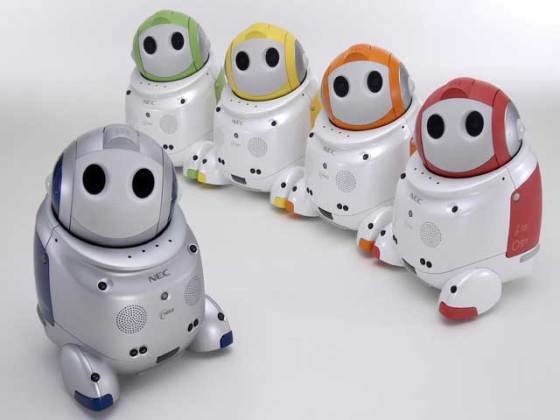NEC PaPeRo robot used to provide activities information to elderly
 PaPeRo (Partner-type-Personal-Robot) – a personal robot from NEC Corporation – has been developed since 1997. It is being developed to interact with people and provide them with more information or entertain them. Due to increasing number of elderly people living alone, the folks from NEC conducted a research where they programmed PaPeRo to provide them with more information about local activities they could participate.
PaPeRo (Partner-type-Personal-Robot) – a personal robot from NEC Corporation – has been developed since 1997. It is being developed to interact with people and provide them with more information or entertain them. Due to increasing number of elderly people living alone, the folks from NEC conducted a research where they programmed PaPeRo to provide them with more information about local activities they could participate.
PaPeRo is a little robotic helper during the day and can play games with people, or when it performs an amusing dance when it is “in a good mood”. It has several different versions which emerged over time, including a Childcare Version (2003 and 2005 revised versions), “PaPe-Jiro” (a robotic comedian), virtual PaPeRo was released in 2006 for use in the PocketPC and any PC running the Windows operating system, and PaPeRo Mini which has half the size of the original in 2009.
The robot is 385mm (15.2 inches) tall and it weights approximately 6.5kg (14.3 punds). It has two wheels in front and one in back, and the two front wheels are driven by two motors. Its head can move up and down and turns left and right, and it is equipped with CCD cameras which are used as its eyes. PaPeRo has three microphones which enable it to estimate the direction of sounds. One directional microphone is installed in the head. In order to reproduce sound, the robot has stereo speakers. There are nine capacitance sensors used to detect human touch.
Aside using CCD cameras to retrieve images of the world around it, PaPeRo has an infrared sensor used to detect if it’s elevated, ultrasonic sensors to avoid bumping into objects in the camera’s blind spots and measure the distances to objects, bumper sensors which detect its collision to something and stop its motors immediately.
Aside its speech, PaPeRo has various LED lamps to indicate its state. Status display LEDs on the chest indicate what PaPeRo is doing and how PaPeRo is feeling. LEDs on the mouth and cheeks indicate its facial expressions. LEDs on the ears indicate when the robot hears human speech and LED around the eyes indicate when it sees people. The eye LEDs blink green when it is searching for people and when it finds them the green shines steadily. When it sees a person’s face it changes to orange.
It is capable to walk around objects, measure the distance and approach people, follow people, remember people and differentiate them. PaPeRo speaks while facing the direction of a person by means of image recognition, and this method also helps to hear the person it is speaking with. A microphone is used for noise cancellation which enables PaPeRo to hear in noisy environment.
In cooperation with local people and Uda City, Nara Prefecture, the folks from NEC performed an experiment which lasted from November 17th to December 17th 2010, where they used PaPeRo in 10 shops and five private homes to provide information to people. The robot connected to the internet in order to find local activities and promote them. The information was elected according to the preferences of each individual hobbies and interests of the elderly, and promoted opportunities for community participation. After the individuals returned, the robot asked them how the activity went. It is capable to remember its companions because, aside face tracking, it is capable to use the image recognition software to compare the face of its companion with the faces of the people it has already spoke to.
After the experiment, the participant filled a questionnaire about their experience with the robot. Over 80% of the people said that they have increased communication with family and acquaintances, and about a 25% increase in the amount of action within the community. This technology could prove useful for elderly because they tend to rely on verbal communication rather than usage of gadgets to find more information.










Cuuuuuute ^_^
I want one!
Agreed that those or similar robots could be used to activate and help the not-so-tech-savvy elderly.